6th International Conference on Trust, Privacy and Security in Digital Business (TrustBus’09), Springer-Verlag, pp. 86-94, September, 2009. DOI
Abstract
SCADA systems represent a challenging scenario where the management of critical alarms is crucial. Their response to these alarms should be efficient and fast in order to mitigate or contain undesired effects. This work presents a mechanism, the Adaptive Assignment Manager (AAM) that will aid to react to incidences in a more efficient way by dynamically assigning alarms to the most suitable human operator. The mechanism uses various inputs for identifying the operators such as their availability, workload and reputation. In fact, we also define a reputation component that stores the reputation of the human operators and uses feedback from past experiences.
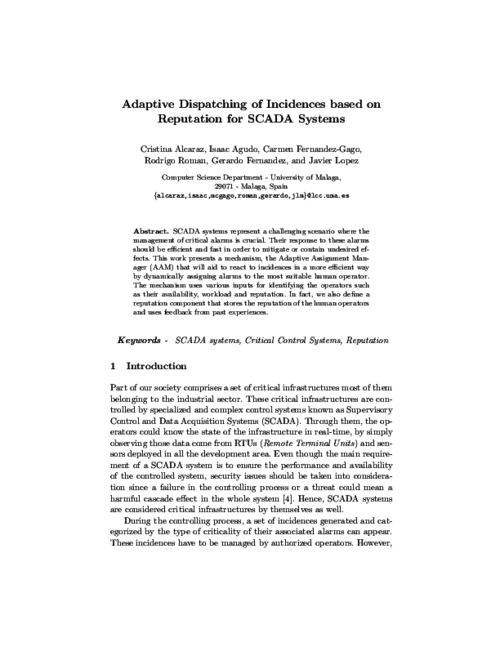
XVII Reunión Española sobre Criptología y Seguridad de la Información, pp. 168-173, 11/2022.

15th International Conference on Trust, Privacy and Security in Digital Business (TrustBus 2018), vol. LNCS 11033, Springer Nature Switzerland AG, pp. 229–243, 09/2018. DOI
Abstract
Recent news have raised concern regarding the security on the IoT field. Vulnerabilities in devices are arising and honeypots are an excellent way to cope with this problem. In this work, current solutions for honeypots in the IoT context, and other solutions adaptable to it are analyzed in order to set the basis for a methodology that allows deployment of IoT honeypot.
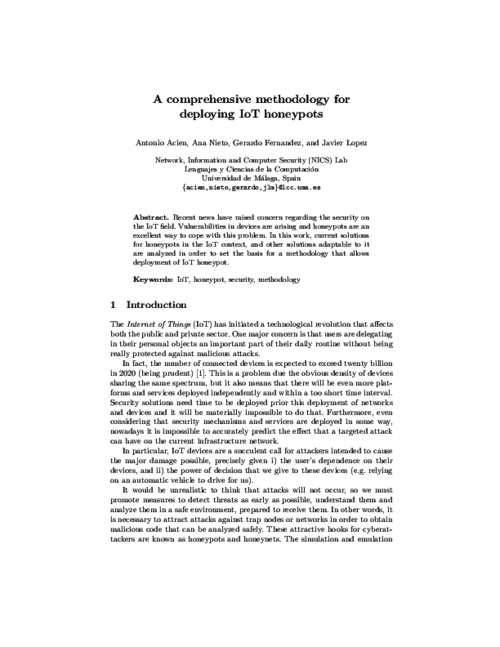
III Jornadas Nacionales de Investigación en Ciberseguridad (JNIC 2017), Servicio de Publicaciones de la URJC, pp. 91-98, 06/2017.
Abstract
Este trabajo propone una arquitectura de despliegue de honeypots adaptativos, configurados dinámicamente a partir de los requisitos del malware que intenta infectar los servicios trampa. A diferencia de otros trabajos sobre honeypots adaptativos, los mecanismos de adaptabilidad aquí diseñados tomarán como base información de inteligencia sobre amenazas actuales, indicadores de compromiso (IOCs) conocidos, así como información de actividades sospechosas actualmente en estudio por los analistas. Este conocimiento será empleado para configurar honeypots de manera dinámica, permitiendo satisfacer los requisitos necesarios para que el malware pueda desplegar toda su operativa.
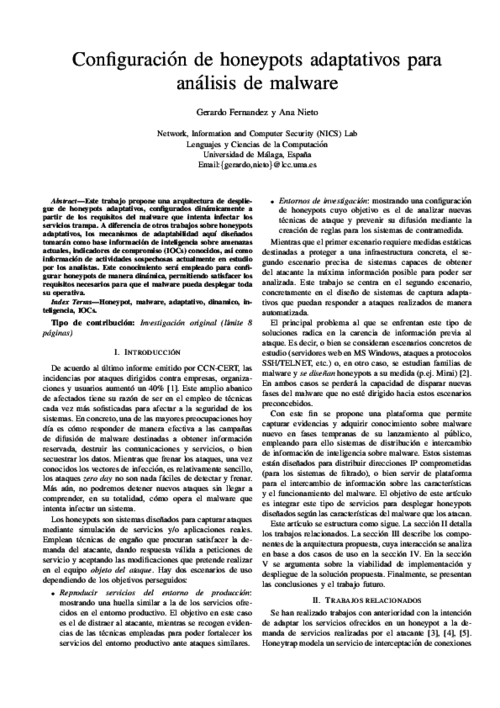
9th International Conference on Risks and Security of Internet and Systems , vol. 8924, Springer International Publishing, pp. 17-34, 04/2015. DOI
Abstract
Anomaly-based detection applied in strongly interdependent systems, like Smart Grids, has become one of the most challenging research areas in recent years. Early detection of anomalies so as to detect and prevent unexpected faults or stealthy threats is attracting a great deal of attention from the scientific community because it offers potential solutions for context-awareness. These solutions can also help explain the conditions leading up to a given situation and help determine the degree of its severity. However, not all the existing approaches within the literature are equally effective in covering the needs of a particular scenario. It is necessary to explore the control requirements of the domains that comprise a Smart Grid, identify, and even select, those approaches according to these requirements and the intrinsic conditions related to the application context, such as technological heterogeneity and complexity. Therefore, this paper analyses the functional features of existing anomaly-based approaches so as to adapt them, according to the aforementioned conditions. The result of this investigation is a guideline for the construction of preventive solutions that will help improve the context-awareness in the control of Smart Grid domains in the near future.
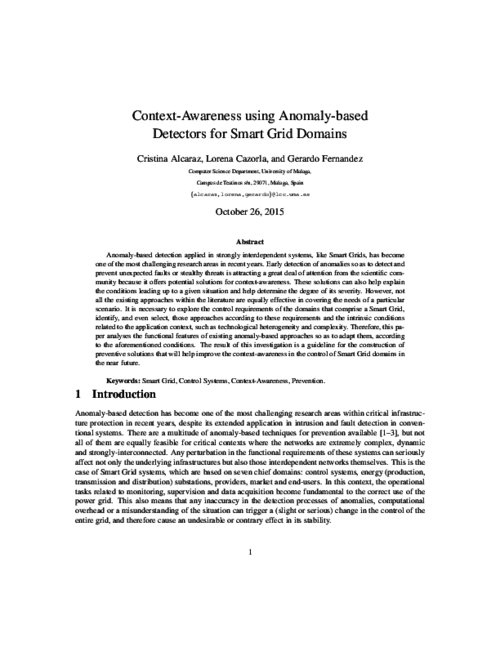
Mobile Networks and Applications (MONET), Springer US, pp. 881-889, 10/2018. DOI
Abstract
Crowdsourcing can be a powerful weapon against cyberattacks in 5G networks. In this paper we analyse this idea in detail, starting from the use cases in crowdsourcing focused on security, and highlighting those areas of a 5G ecosystem where crowdsourcing could be used to mitigate local and remote attacks, as well as to discourage criminal activities and cybercriminal behaviour. We pay particular attention to the capillary network, where an infinite number of IoT objects coexist. The analysis is made considering the different participants in a 5G IoT ecosystem.
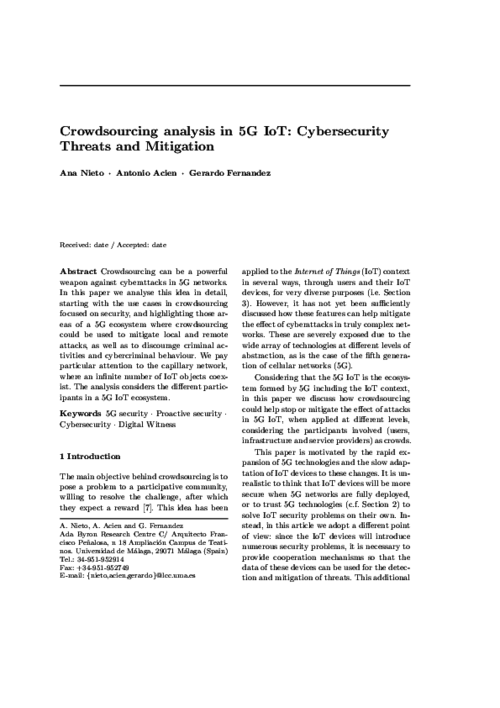
XV Reunión Española sobre Criptología y Seguridad de la Información, 10/2018.
Abstract
Con la revolución tecnológica que ha supuesto la Internet de las Cosas (Internet of Things, IoT) se han presentado escenarios donde la preocupación por la seguridad en dicho entorno es cada vez más relevante. Están comenzando a surgir vulnerabilidades en varios dispositivos, y los sistemas trampa son una excelente manera de lidiar con este problema. En este trabajo se analizan soluciones para honeypots en el entorno IoT (y en otros que se puedan adaptar) para sentar las bases de una metodología que permita el despliegue de honeypots IoT.
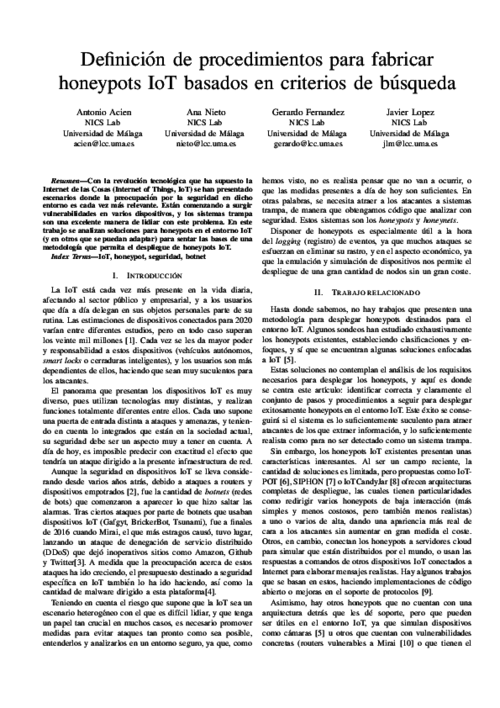
Nuevas tendencias en gestión de redes, Novática, no. 196, CEPIS, pp. 20-25, December, 2008.
Abstract
En el momento que se introduce en el mercado nuevas tecnologías basadas en entornos distribuidos comienzan a surgir en paralelo nuevos problemas de seguridad en los sistemas SCADA (Supervisory Control and Data Acquisition), los cuales monitorizan y gestionan otras infraestructuras de gran complejidad y escala. Un fallo o una interrupción en uno de sus componentes podría suponer un impacto negativo sobre la funcionalidad de otras infraestructuras, por lo que se hace necesario realizar frecuentes análisis de seguridad para así mantener actualizado el conocimiento y proveer recomendaciones y/o soluciones para mitigar o evitar futuras ocurrencias, garantizando una gestión de red fiable y siempre disponible.

9th Future Security Conference, 2014.
Abstract
The rapid rate of change in technology and the increasing sophistication of cyber attacks require any organization to have a continuous preparation. However, the resource and time intensive nature of cybersecurity education and training renders traditional approaches highly inefficient. Simulators have attracted the attention in the last years as a potential solution for cybersecurity training. However, in spite of the advances achieved, there is still an urgent need to address some open challenges. In this paper we present a novel simulator that solves some these challenges. First, we analyse the main properties that any cybersecurity training solution should comprise, and evaluate to what extent training simulators can meet them. Next, we introduce the functional architecture and innovative features of the simulator, of which a functional prototype has already been released. Finally, we demonstrate how these capabilities are put into practice in training courses already available in the simulator.
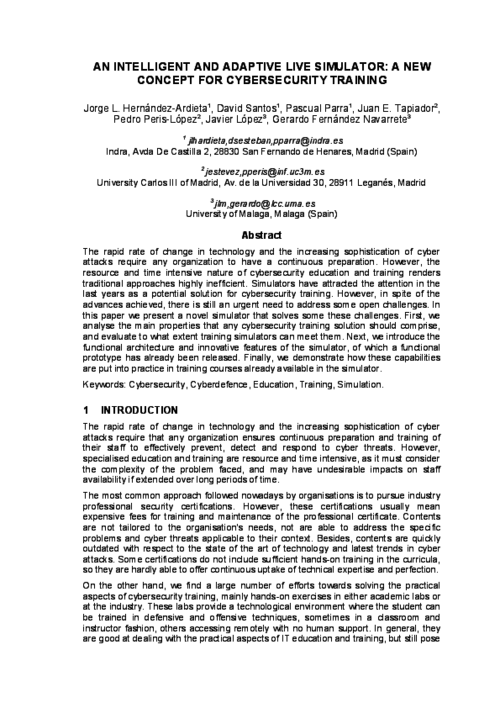
14th International Conference On Trust, Privacy & Security In Digital Business (TrustBus 2017), vol. 10442, Springer International Publishing, pp. 130-144, 08/2017. DOI
Abstract
In this paper we propose the Hogney architecture for the deployment of malware-driven honeypots. This new concept refers to honeypots that have been dynamically configured according to the environment expected by malware. The adaptation mechanism designed here is built on services that offer up-to-date and relevant intelligence information on current threats. Thus, the Hogney architecture takes advantage of recent Indicators Of Compromise (IOC) and information about suspicious activity currently being studied by analysts. The information gathered from these services is then used to adapt honeypots to fulfill malware requirements, inviting them to unleash their full strength.
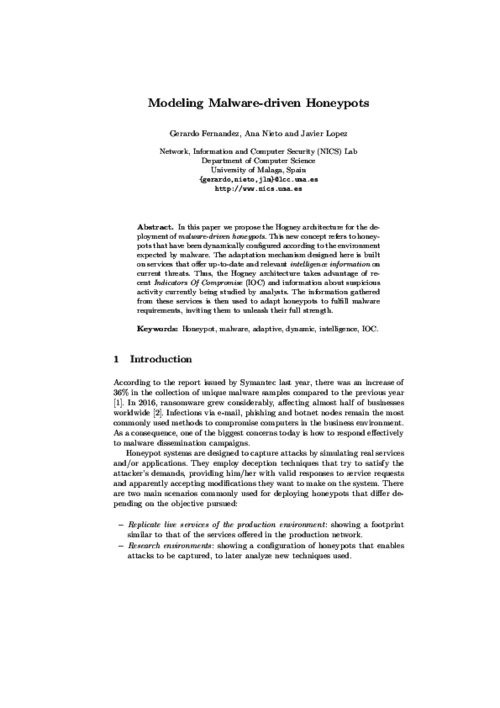
Novatica, New Trends in Network Management, vol. 9, no. 6, Cepis UPGRADE, pp. 22-28, December, 2008.
Abstract
When a Supervisory Control and Data Acquisition (SCADA) system monitors and manages other complex infrastructures through the use of distributed technologies, it becomes a critical infrastructure by itself: A failure or disruption in any of its components could implicate a serious impact on the performance of the other infrastructures. The connection with other systems makes a SCADA system more vulnerable against attacks, generating new security problems. As a result, it is essential to perform diverse security analysis frequently in order to keep an updated knowledge and to provide recommendations and/or solutions to mitigate or avoid anomalous events. This will facilitate the existence of a suitable, reliable, and available control network.
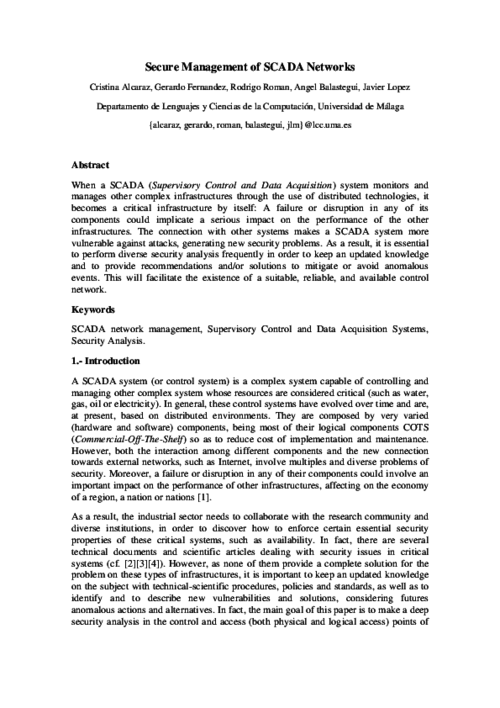
Critical Infrastructure Protection: Information Infrastructure Models, Analysis, and Defense, J. Lopez, S.. Wolthunsen, and R. Setola Eds., Advances in Critical Infrastructure Protection: Information Infrastructure Models, Analysis, and Defense. LNCS 7130. 7130, Springer-Verlag, pp. 120-149, September 2012.
Abstract
SCADA Systems can be seen as a fundamental component in Critical Infrastructures, having an impact in the overall performance of other Critical Infrastructures interconnected. Currently, these systems include in their network designs different types of Information and Communication Technology systems (such as the Internet and wireless technologies), not only to modernize operational processes but also to ensure automation and real-time control. Nonetheless, the use of these new technologies will bring new security challenges, which will have a significant impact on both the business process and home users. Therefore, the main purpose of this Chapter is to address these issues and to analyze the interdependencies of Process Control Systems with ICT systems, to discuss some security aspects and to offer some possible solutions and recommendations.

XII Reunión Española sobre Criptología y Seguridad de la Información (RECSI 2012), pp. 45-50, Sep 2012.
Abstract
En este trabajo proponemos una plataforma para el desarrollo de un sistema colaborativo para la detección y reacción ante intrusiones, empleando como base las tecnologías presentes en Intel vPro. La solución presentada está dirigida a solventar la necesidad de implantación de nuevas tecnologías que posibiliten la reacción ante ataques, independientemente del sistema operativo usado. Con este fin, en este trabajo abordamos tres puntos fundamentales: la detección de intrusiones colaborativa, la respuesta automática de los nodos ante la detección de una intrusión y el uso de herramientas que posibiliten asegurar la confianza en un nodo. En un sistema colaborativo como el que se propone aquí, un aspecto clave para la seguridad es la protección de las comunicaciones entre los mecanismos de detección y reacción frente a intrusiones. La modificación o el simple acceso a los datos intercambiados por tales sistemas supone un grave riesgo para la seguridad del entorno. Como resultado hemos desarrollado un prototipo preliminar para probar la solución propuesta en un escenario de ataque real.
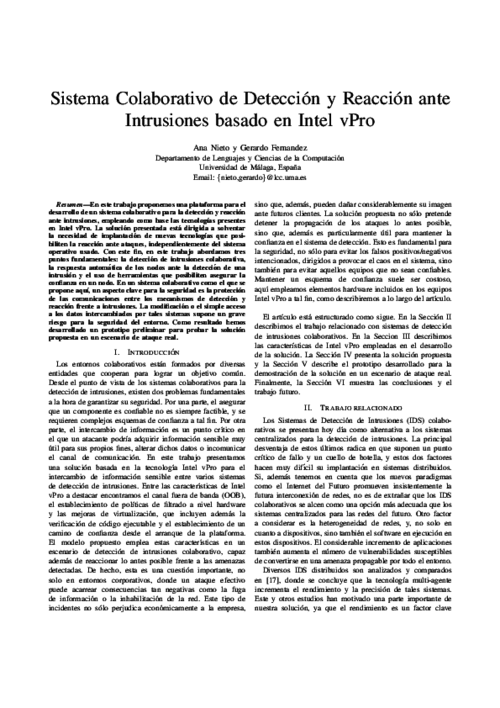
 ]
]